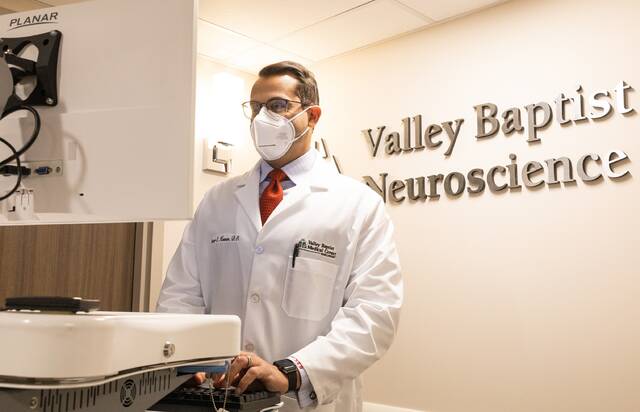
HARLINGEN – A bump on the head.
That’s all it takes to alter your life and force you to start all over.
March is Brain Injury Awareness Month, and the Brain Injury Association of America wants everyone to understand more fully this often misunderstood malady in all of its complexities.
BIAA says brain injury is a leading cause of death and disability, with at least 2.8 million Americans sustaining a traumatic brain injury each year. Of those, 48 percent are from falls, 17 percent are from being struck by or against something, and 13 percent are caused by motor vehicle accidents.
A smaller percentage occur because of assaults.
Here in the Valley, the number one cause of TBI among young people is motor vehicle accidents, says Dr. Ameer Hassan, chief of the neuroscience department at Valley Baptist Medical Center – Harlingen.
“Motor vehicle accidents are always the ones that cause the most injury in your average patient in the Valley,” Hassan said.
Even accidents involving bicycles and roller blades can result in a TBI.
Nationally, the largest group of TBI patients are aged 75 and over, Hassan said, and that’s because of falls. For this reason, younger generations must ensure homes have the proper railing and other accommodations.
“It’s extremely important to make sure that your parents, your grandparents, your great uncle, whoever’s older and fits that age category, that they have rails in their showers to hold onto, that they don’t have loose carpeting anywhere,” Hassan said. “They should make sure that they’re able to get up and down their stairs, just making the house more friendly to the elderly and less likely to cause a fall. That’s just something we should pay attention to this month.”
However, a person doesn’t have to fall or take a blow to the head to sustain a brain injury.
Strokes can also cause serious damage to the brain and derail people’s lives. In fact, if one factors in strokes, the number of new cases of brain injury increases from 2.8 million to almost 4 million, Hassan said.
“The big thing here is about awareness of signs and symptoms and knowing that something like a concussion or a fall can lead to something significantly more like mortality,” Hassan said.
Some symptoms of brain injury closely resemble stroke: balance problems, vision problems, facial drooping, arm or leg weakness and slurred speech.
If an individual is experiencing any of these, someone should call 911 or take the patient directly to the closest emergency room. What appears to a simple bump on the head could in fact be an expanding hemorrhage.
“If you just go back to sleep on it, you might not wake up the next morning,” Hassan said.
He referred now to the tragic story of the late British actress Natasha Richardson who died in 2009 after falling and hitting her head while skiing.
“She said she had a little bit of a headache, and she just went back to her room,” Hassan said. “Everybody was like, ‘OK, she’s fine,’ and she didn’t go to the ER. And then she’s dead the next morning because she had a subdural hemorrhage that continued to expand and herniated her brain.”
News flash: there is no little “bump on the head.” Get to the hospital and get checked out.



